The gap between Canada's proposed climate efforts and its 2030 Paris Agreement target has grown even wider in the last year. The federal government is now predicting a gap larger than all emissions from the province of Quebec.
The numbers come from the latest climate pollution projections report,"Canada's Greenhouse Gas and Air Pollutant Emissions Projections 2018." Each year, the government tallies up its projections, and each year the picture has gotten worse.
Back in 2016, the Canadian government projected that all current and proposed policies (plus emissions credits they hope to be able to count) would get Canada to within 44 million tonnes of CO2 (MtCO2) of the 2030 target.
The next year the projected "emissions gap" widened to 66 MtCO2.
And now, the government's newest projections show the gap has widened even further. They now project a gap of 78 MtCO2.
Unfortunately, that's the good news.
According to the new report, Canada's actual emissions are projected to be even higher than that: 115 MtCO2 above their 2030 Paris target, or less than halfway to the target.
The government is hoping to reduce that number by 37 MtCO2 in "emissions credits" which would be bought from California and claimed from carbon in Canada’s forests. However, these credits are uncertain. For one thing Canada doesn't have permission to count them under the Paris Agreement. For another, the amount is speculative at this point (I’ll get into the details below).
With or without these credits, the latest report shows that Canada is on track to miss its 2030 climate target by a large and growing amount.
To illustrate Canada's widening emissions gap, I've created a series of charts that tell the story behind the latest government data.
Step 1: The goal
First, the goal.
Both Stephen Harper and Justin Trudeau committed to meeting the same climate target for 2030. That goal, pledged under the global Paris Agreement, is to reduce climate pollution to thirty per cent below 2005 levels.
That works out to a reduction in annual emissions of 220 MtCO2 below 2005 levels.
To make it visual, imagine progress in reducing climate pollution as a green arrow stretching from the 2005 starting line on the left, to the 2030 goal line on the right.
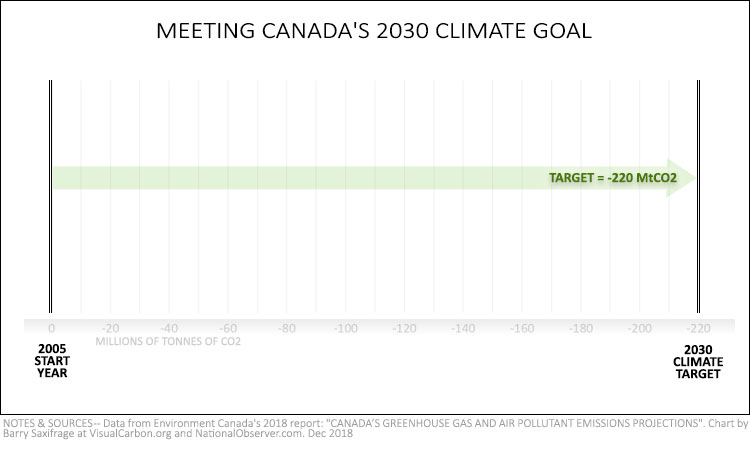
Step 2: Current climate policies
Next, let's look at the impact of Canada's current climate policies.
The chart below includes a coloured bar showing emissions for each sector of the economy. The length of the bars indicates the projected change in emissions for that sector between 2005 and 2030, given current policies.
Starting with the electricity sector, the green bars show which sectors are expected to reduce climate pollution. Each of these move Canada closer to the goal line. Then, the red bars show sectors on track to increase climate pollution above the 2005 level. These push back the progress we're making.
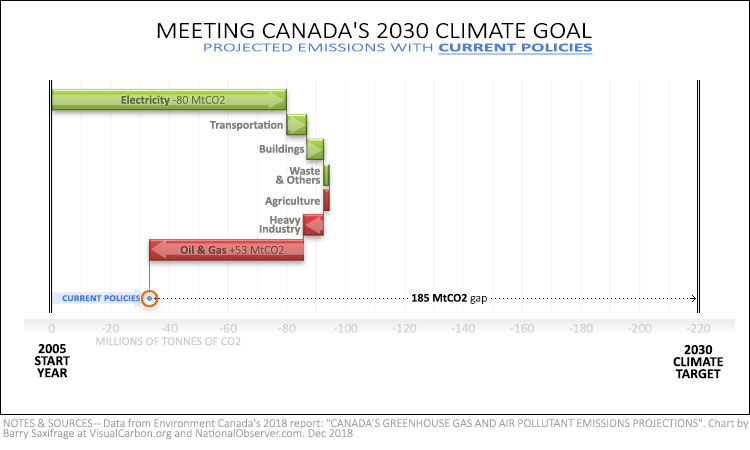
The blue arrow in the bottom left shows the net result for Canada. As you can see, Canada's current climate policies fall short of the 2030 climate commitment by a long way.
It's worth underlining the two sectors that dominate this storyline.
Electricity: Under current policies, almost all of Canada’s emissions cuts are expected to come from the electricity generation sector. It's on track to emit 80 MtCO2 less in 2030 than 2005. This is being driven by two major climate policies. First, Ontario eliminated coal-fired generation. Second, the federal government has passed laws to phase out coal-fired generation nationwide.
Oil & Gas: At the other extreme, the oil & gas extraction sector is on track to cause almost all of the expected increase in climate pollution. Under current policies, this sector is projected to emit 53 MtCO2 more in 2030 than in 2005. That erases most of the progress made by the electricity sector and pushes Canada's climate progress back almost to the starting line. The primary driver is the ever-rising amounts of bitumen being extracted from the Alberta oilsands.
Step 3: Proposed policies
The federal and provincial governments have proposed — but not yet enacted — several new climate policies. These would improve the situation but would still get Canada less than halfway to the goal. The third version of my chart tells that story.
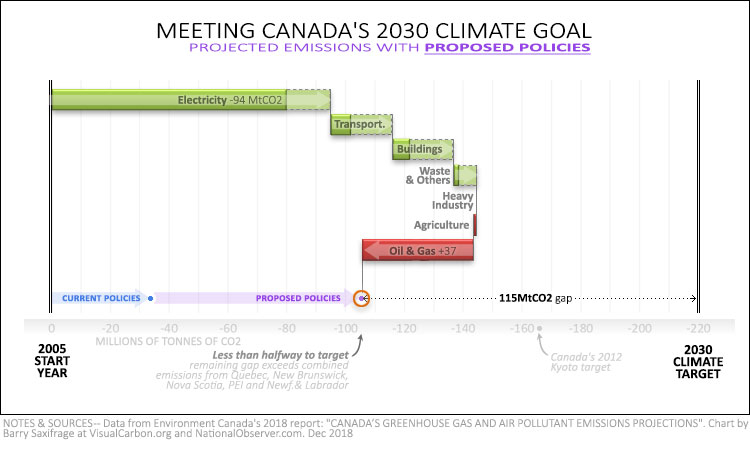
The bars on the chart above show the impact of these proposed policies.
For the green sectors, the extra emissions cuts are shown as dashed extension to their bars. These four sectors combined are expected to cut an additional 48 MtCO2.
In contrast, the proposed policies will reduce the combined climate pollution from the three red sectors by half that much — 24 MtCO2. This shrinks the length of each red bar slightly, but not enough to turn any of them green.
The purple arrow at the bottom shows the national total from all the proposed climate policies. As you can see, even if the new policies are fully enacted, Canada fails to get even halfway to its goal.
The remaining emissions gap is 115 MtCO2. For scale, that's more than the projected emissions from Quebec, New Brunswick, Nova Scotia, PEI and Newfoundland & Labrador, combined.
What now?
Step 4: Hoping for credits
As I mentioned at the outset, the Canadian government is also hoping to count some "emissions credits" towards the target.
The new report lists projections for two kinds of "credits." One is an ongoing effort to claim credits that Quebec is buying from California under the Western Climate Initiative (WCI). The second is a newly introduced effort to count some carbon credits from Canada’s forests (LULUCF).
Both are speculative at this point. My chart shows them as dashed grey boxes, just below the oil & gas sector. They are currently projected to add up to 37 MtCO2 in 2030.

For those interested in the details of these hoped-for credits, I'll provide a brief tour at the end of this article.
But the most important thing to note is that even if the government finds a way to count these credits, Canada still wouldn’t be close to meeting its 2030 Paris target. Canada's climate gap would be 78 MtCO2. That's more than the province of Quebec emits today.
And, as mentioned above, this emissions gap keeps growing significantly wider each time the government updates its projections.
A quick glance at the chart reveals the primary cause of Canada's emissions gap.
Step 5: The role of rising oil & gas emissions
The Canadian government has said repeatedly and emphatically that they are committed to meeting the 2030 climate target. To do that, they will have to rein in the overwhelming driver of climate failure so far — oil & gas sector emissions.
My final chart illustrates this necessity.
If the oil & gas sector reduced emissions in line with the national goal — a 30 per cent reduction from 2005 levels — then this sector's emissions would fall by 47 MtCO2 by 2030. The yellow bar on the chart shows what this would look like.
In this scenario, Canada as a whole would be on track to meet its 2030 Paris climate target.
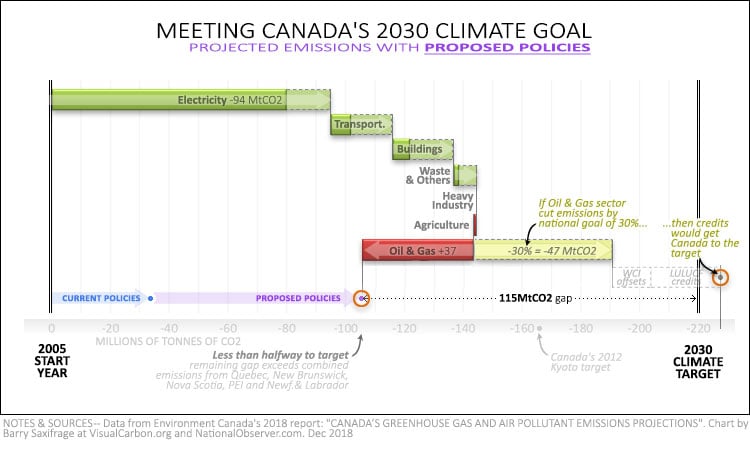
However, instead of reducing emissions, the oil & gas sector is on track to increase its climate pollution by 23 per cent. That's creating an emissions gap from just this one sector of 84 MtCO2. And as we've seen above, that's bigger than the nation's entire gap.
If the government continues on the current path of allowing the oil & gas sector to emit 84 MtCO2 more than its share of the nation's target, then they will need to choose other parts of the economy to make large additional cuts to make up for it. That's known as "burden shifting" and in this case the burden is the size of all the emissions from Canada’s second most populous province.
That’s the elephant in the room when it comes to Canada's climate goals. How large will governments allow the oil & gas emissions burden to grow? And the follow-up question is: who will government pick to shoulder that burden?
Unfortunately, as with previous climate reports, the government fails to address these critical questions. Instead of answers, it projects only a widening climate gap — now 78 to 115 MtCO2 — without any specifics about how it plans to close the gap.
Extra credits
For those of you interested in a brief overview of the two emissions credit systems the government is pursuing, read on.
1) California WCI Credits
The government's first hope for emissions credits is to find a way to count the Western Climate Initiative (WCI) offsets that Quebec is planning to buy from California.
Quebec is projected to purchase around 13 MtCO2 of credits by 2030. The province is buying them instead of cutting emissions at home, because they think it will be less expensive to pay California to cut emissions.
Unfortunately for Canada, the WCI offsets aren't currently valid under the Paris Agreement.
Moreover, the Americans have shown no sign that they are willing to do the heavy lifting that would be required to make them valid. For Canada to count cuts made by California, the USA would need to not count them. In other words, the Americans would need to report higher levels of emissions than they actually released. Otherwise there would be "double-counting."
Further muddying the waters is the ongoing inability of the world's nations to agree on the required rulebook for using international offsets of any kind under the Paris Agreement. The last two UN meetings that were meant to resolve the issue ended without an agreement.
So, there are a lot of roadblocks that Canada needs other people to clear before it can count any WCI offsets towards its 2030 climate target. If these aren't allowed then Canada's emissions gap jumps to 91 MtCO2.
2) Forest carbon (LULUCF) Credits
The second hope for credits lies in a new carbon accounting computer model that Canada is putting together for its forests. It falls under the tongue-twisting category of "Land Use, Land Use Change and Forestry" (LULUCF).
This is the first year that Canada has provided an estimate for how many of these credits it might try to claim. The current estimate is for 24 MtCO2 in 2030.
There are several reasons these credits are speculative at this point:
* Not authorized yet – Canada is creating its own computer model for forest carbon and the world hasn't agreed to the rules for them yet. As Canada's report says: "UNFCCC negotiations on guidance for accounting in the post-2020 time period are ongoing, the outcome of these negotiations may influence Canada's final LULUCF accounting approaches." As a result, the government cautions that any projections it makes "should be viewed as preliminary and provisional."
* Complicated computer models – The report admits that "the identification of the direct human influence on emissions and removals is challenging since emissions and removals are affected by both human activities and by natural events (e.g. drought, fire, insect infestations, etc.), as well as by natural processes (e.g. forest growth)."
* Speculative assumptions – Some of the critical assumptions Canada is making are uncertain. Any changes could easily wipe out expected credits. For example, government is assuming that logging levels will be significantly lower in 2030 than in the past. They are assuming that wood products will be used in ways that release CO2 more slowly in the future. They are assuming wildfires won't increase. And so on.
* Canada's managed forests are actually emitting carbon — Lots of it. The government's own calculations show that Canada's managed forests have transitioned from small carbon sinks into large carbon emitters in recent years.
I've created a chart using the report's data from 1990 to 2016 to illustrate this trend. The bold red and green line shows the annual carbon gain or loss from Canada's managed forestlands. The green parts of the line show years in which the forests stored carbon. The red parts of the line are years in which the forests emitted carbon.
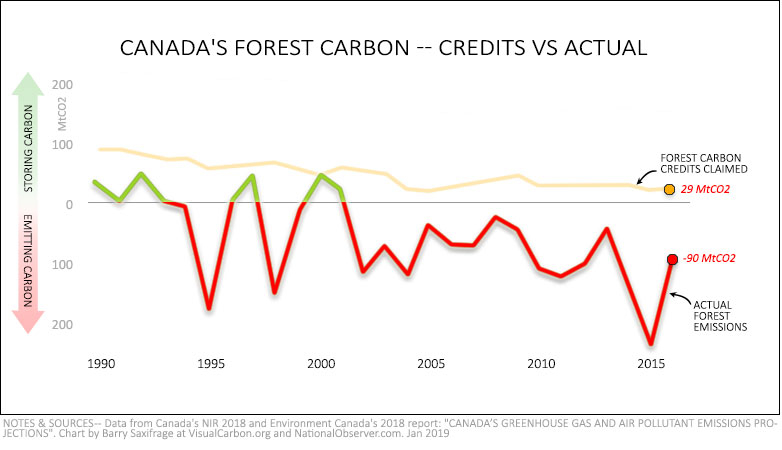
The primary reason for this switch to carbon emitting is the increasing scale of wildfires and insect outbreaks. Both increases are being driven in large part by human-induced climate change.
Even though our forests are shifting into being huge carbon emitters, Canada hopes to claim carbon credits from them. The yellow line on the chart shows the amount. The feds arrive at this number by ignoring the increasing emissions from wildfires and insects. Their rationale is that these are "natural" and not "anthropogenic.”
Whether Canada can find a way claim carbon offsets from forestlands that have become large carbon emitters is yet to be seen.
Excellent report!
Excellent report!
If the plan is to count negative emissions from forests surely we’ll have to count positive emissions from melting permafrost. Or are we only going to tally the items that bring down our total emissions? Such evil genius in that case. I’m sure no one will notice.
Brilliant. Too bad our
Brilliant. Too bad our political leaders lack the guts to be honest about these issues.
Forest systems across the
Forest systems across the planet have widely flipped from carbon sink to carbon source (US Western national forests, the Amazon, Alaska, and British Columbia forests.) Without a reduction of current temperature, Earth systems emissions will continue to grow, not decline, because the warming that caused Earth systems collapses begin will not allow stable ecosystems to be restored, much less additional warming. In the meantime Canada ignores home grown technology that cools the surface, increases primary energy production and mitigates sea level rise and ocean acidification. Cdn patent application 2,958,456 - Method and apparatus for load balancing trapped solar energy.
As usual Barry. But our
As usual Barry. But our future is even worse than this. This trend is not just Canadian, not just Trudeau and his refusal to recognize the fundamental connection between the economy and the environment. It is GLOBAL!. Another dismal climate forecast was published in Climate News Network this morning (https://climatenewsnetwork.net/human-carbon-emissions-to-rise-in-2019/).
Hi Barry
Hi Barry
Just a quick note to thank you for the amazing work you have been doing. I wish gov't efforts indicated a positive response, but, as you so compellingly illustrate - they do not.
Have you an analysis such as the above for the new BC Plan? It seems to be heavy on incentives and very light on compulsion, which in my view might have been appropriate in 1990, but no longer.
Thanks for your work
Cliff Stainsby
* Canada's managed forests
* Canada's managed forests are actually emitting carbon — Lots of it. The government's own calculations show that Canada's managed forests have transitioned from small carbon sinks into large carbon emitters in recent years.
THIS ...IS INSANE !!!!!
Barry Saxifrage....Please see
Barry Saxifrage....Please see BURNED THE MOVIE https://burnedthemovie.com/the-film/
Very interesting report Mr
Very interesting report Mr Saxifrage; thank-you. Makes our personal target for this year (-~1.5 tonnes) seem a little inadequate. I will have to pick it up a notch.
Interesting coincidence that the combined carbon credits (37 million tonnes) are = to the proposed policy reductions forecast for the oil and gas industry.
I'm really against Canada
I'm really against Canada paying others to do our heavy lifting for us through carbon credits. This is really just a cop-out, and a pathetic one at that. I don't buy the argument that California can more cheaply reduce carbon than we can. They'll be taking advantage of any low-hanging carbon fruit anyway as they struggle to reduce their own carbon footprint.
Further to count so-called Forest Credits is just more political BS. The analysis in this article is counting NEW actions to reduce emissions to a level below 2005 levels. Well, the forest was there in 2005 and before, so the only Forest Credits that make any sense at all, would be any net forest-size-gain after 2005. Oops, there's less than before due to big climate-induced forest fires, clear-cutting, and the process of turning our forests into toilet paper!
I suggest we try for some toilet credits, since our government's climate policy is full of sh*t. We could sequester the government's climate policy and save considerable greenhouse gas that way. In fact, let's stop all the CO2 coming out of parliament these days by inserting corks fore and aft, and really wipe that gap out. Okay, feeling better now, just had to blow off a little steam there; I'll buy a credit and count the tree in the back yard to cover my outburst.
Being addicted to oil sure
Being addicted to oil sure makes things difficult! Climate change is not new it has been with us a long time but because of the energy high we get from it we can ignore the obvious and live in the land of the delusional! That lack of rational thinking plus a dysfunctional electoral system has taken us to the edge and yet people still pretend that it’s not their problem that it’s someone else’s and that if you ignore it, it will go away! We are the problem and until we fix it things will never get better only worse much worse! Wake up people!
Thanks for the clear
Thanks for the clear discussion and graphics that show the difficulties in meeting the federal emissions target for 2030. Need I mention that the federal goal itself is inadequate for the Paris goal of 2 degrees Celsius? And that the UN's report in October 2018 indicated that the 2 degrees goal is inadequate? Extending the charts to show Canada's share of the 1.5 degrees aspiration would be most informative. It would emphasize that a fundamental rethinking of proposed solutions is required.




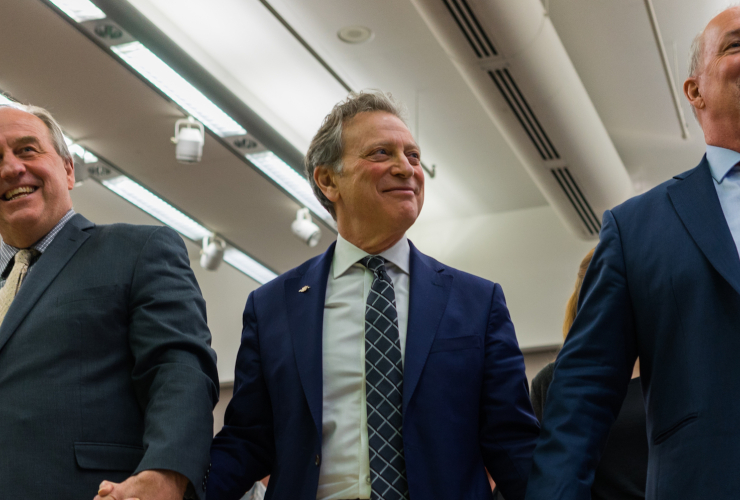
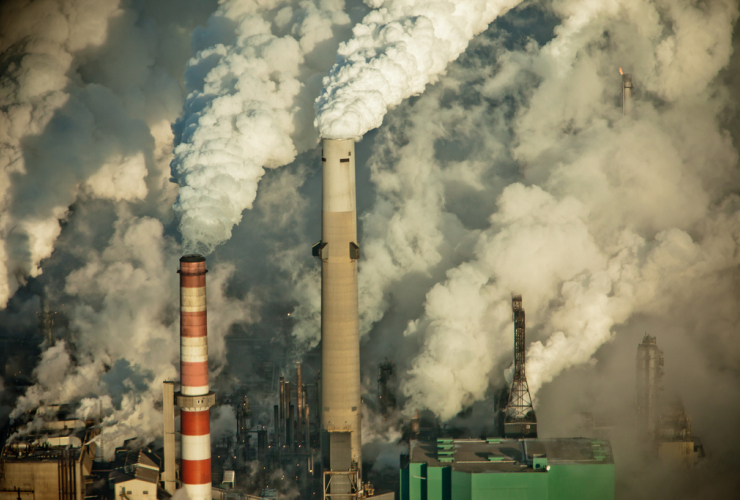
Comments